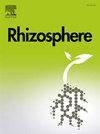豇豆品种的共生 N2 固定能力通过接种优良的巴西根瘤菌株明显增强
IF 3.4
3区 生物学
Q1 PLANT SCIENCES
引用次数: 0
摘要
豇豆[Vigna unguiculata (L.) Walp]具有出色的大气固氮能力,因此对资源有限的热带地区的土壤可持续性和生产力做出了重大贡献。然而,部分由于生物接种剂的无效性和有限性,豇豆在田间的共生氮贡献和产量仍然很低。因此,本研究考察了精英豇豆感染臂柄菌菌株(CP-24 和 CP-37)对四个豇豆品种(Keti、TVU、黑眼豆和白花蔓)的芽生物量和共生氮贡献的影响。为此,我们在三个地点进行了为期两年的田间试验,采用四次重复的因子随机完全区组设计。15N 技术的自然丰度用于计算共生氮的贡献。接种巴西根瘤菌可显著提高结核形成率、氮固定率、氮固定量和芽生物量,这证明了菌株提高土壤肥力的有效性和能力。与未接种菌株的对照组相比,接种 CP-24 菌株的豇豆嫩芽氮含量、氮固定率和氮固定量分别提高了 40%、15% 和 41%。此外,接种剂与品种的交互作用对结核数量、结核干重和固定氮量有显著影响,TVU 和 White Wonderer 拖尾与 CP-24 的组合表现最为突出。生物量积累与固氮量之间以及固氮量与种子产量之间也有很强的正相关性。因此,建议在所有三个测试地点和类似的农业生态条件下,在豇豆品种 TVU 和 White Wonderer 拖尾上接种铜绿假丝酵母菌与 CP-24 菌株,以提高豇豆的共生氮贡献和相关产量优势。这项研究强调,使用精英和作物特异性臂柄霉菌株可提高共生氮贡献、土壤肥力和豆科植物的产量表现。因此,它有助于资源贫乏的农民在降低气候变化风险的同时实现粮食安全。本文章由计算机程序翻译,如有差异,请以英文原文为准。
Symbiotic N2 fixation in cowpea varieties is markedly enhanced by inoculation with elite Bradyrhizobium strains
Because of its excellent ability to fix atmospheric nitrogen, cowpea [Vigna unguiculata (L.) Walp] makes a significant contribution to soil sustainability and productivity in the resource limited tropical regions. However, due to in part to ineffectiveness and limited availability of bio-inoculant, its symbiotic N contribution and yield remained low in the field. Therefore, this study examined the effect of elite cowpea infecting Bradyrhizobium strains (CP-24 and CP-37) on shoot biomass and symbiotic nitrogen contributions of four cowpea varieties (Keti, TVU, Black eye bean, and White wonderer trailing). For this a two-year field experiment was carried out at three sites using a factorial randomized complete block design with four replications. The natural abundance of the 15N technique was used to compute the symbiotic N contribution. Bradyrhizobium inoculation led to significantly higher nodule formation, % Ndfa, amounts of N fixed, and shoot biomass, demonstrating the effectiveness and ability of the strains to enhance soil fertility. Inoculating cowpea with CP-24 strain increased shoot N content, % Ndfa and N fixed by 40%, 15%, and 41%, respectively, in comparison to the un-inoculated control. Furthermore, the inoculant by variety interaction had a significant effect on nodule number, nodule dry weight, and amount of N fixed, with TVU and White Wonderer trailing in combination with CP-24 exhibiting the most outstanding performance. There was also a strong positive correlation between biomass accumulation and N fixed, as well as N fixed and seed yield. Therefore, Bradyrhizobium inoculation on cowpea varieties TVU and White Wonderer trailing with CP-24 strain is recommended at all three tested sites and similar agro-ecologies for improved symbiotic N contribution and associated yield advantage of cowpea. This study highlights that, the use of elite and crop specific Bradyrhizobium strains can boost symbiotic nitrogen contribution, soil fertility, and the yield performance of legumes. Thus, it helps resource-poor farmers who are suffering from rising mineral fertilizer cost to achieve food security while reducing climate change risks.
求助全文
通过发布文献求助,成功后即可免费获取论文全文。
去求助
来源期刊

Rhizosphere
Agricultural and Biological Sciences-Agronomy and Crop Science
CiteScore
5.70
自引率
8.10%
发文量
155
审稿时长
29 days
期刊介绍:
Rhizosphere aims to advance the frontier of our understanding of plant-soil interactions. Rhizosphere is a multidisciplinary journal that publishes research on the interactions between plant roots, soil organisms, nutrients, and water. Except carbon fixation by photosynthesis, plants obtain all other elements primarily from soil through roots.
We are beginning to understand how communications at the rhizosphere, with soil organisms and other plant species, affect root exudates and nutrient uptake. This rapidly evolving subject utilizes molecular biology and genomic tools, food web or community structure manipulations, high performance liquid chromatography, isotopic analysis, diverse spectroscopic analytics, tomography and other microscopy, complex statistical and modeling tools.
 求助内容:
求助内容: 应助结果提醒方式:
应助结果提醒方式:


